Kashmir Great Lakes Trek
Trek Grade
Moderate-Difficult
Highest Altitude
13,750 ft.
Base Camp
Sonmarg
Trek Duration
8- Days
Overview
The Kashmir Great Lakes Trek is one of the most beautiful adventures in India. This trek takes you into the heart of the Himalayas, where nature shows its true magic. You will see snow-capped mountains, wide-open meadows, and sparkling lakes that look like glass.
This trek lasts 7 to 8 days and covers around 75 kilometers. The highest point is the Gadsar Pass, which stands tall at 13,750 feet. Along the way, you will visit many pristine alpine lakes. These include Vishansar Lake, Kishansar Lake, and the peaceful Gangabal Lake. Each lake is surrounded by towering peaks, creating views that feel like a dream.
The journey begins at Sonamarg, a small town filled with green valleys and glacial rivers. From there, the trail leads you through meadows dotted with wildflowers and forests of maple and pine trees. As you climb higher, the views get even more stunning. You’ll cross snowy patches and see shining glaciers that seem close enough to touch.
At night, you’ll camp under the stars. The silence of the mountains, broken only by the sound of a stream or the wind through the trees, creates a peaceful escape. It’s a chance to disconnect from the world and connect with nature.
This trek is not just about seeing beautiful places. It is also a test of your strength. The long walking days and steep climbs will challenge your body and mind. But the rewards are worth doing the Kashmir Great Lakes Trek. Every lake, every peak, and every sunrise fill you with awe and wonder.
Prepare well before starting this adventure. Pack the right trekking gear and train your body. The Kashmir Great Lakes Trek is more than a journey—it’s an unforgettable experience. From the colorful Shekdur meadow to the calm waters of the Satsar Lakes, every step leaves you with memories to treasure forever.
Curious about what lies ahead? In the sections below, we’ll guide you through everything you need for this adventure. Explore the trek’s full route, learn what gear to pack, and discover tips to prepare physically and mentally. We’ll also share insider details about the best sights, camping spots, and hidden wonders that make this journey memorable.
Available Dates
July 2024
| Date | Status |
|---|---|
| 22 June 2024 | Open |
| 23 June 2024 | Open |
| 29 June 2024 | Open |
| 30 June 2024 | Open |
| 06 July 2024 | Open |
| 07 July 2024 | Open |
| 08 July 2024 | Full |
August 2024
| Date | Status |
|---|---|
| 22 June 2024 | Open |
| 23 June 2024 | Open |
| 29 June 2024 | Open |
| 30 June 2024 | Open |
| 06 July 2024 | Open |
| 07 July 2024 | Open |
| 08 July 2024 | Full |
Inclusions & Exclusions
Kashmir Great Lakes Trek Highlights
- Beautiful Lakes: The trek takes you to stunning, high-altitude lakes like Vishansar, Krishansar, and Gadsar.
- Scenic Views: Enjoy breathtaking views of snow-capped mountains, lush green meadows, and deep valleys.
- Wildlife: Spot rare animals like Himalayan brown bears, marmots, and many types of birds.
- Adventure: The trek is thrilling with challenging passes like Gadsar Pass and others.
- Camping: Sleep under the stars at beautiful campsites near the lakes and meadows.
- Cultural Experience: Meet local shepherds and learn about life in the mountains.
Kashmir Great Lakes Trek Package and Cost
| Item | Cost |
|---|---|
| Trek Cost | 15,000 ₹/ Person (ex Srinagar) |
| Transportation | Included in the Trek Price |
| Offloading/ Porter Service | 2400 ₹/ Bag |
| Insurance | 650₹ / Person |
This Kashmir Great Lakes Trek Package includes all costs for the trek. It covers camping gear, transport, meals, trained staff, medical help, and other essentials. TravElsket offers the best price with top service.
How to Book Your Trek
Booking your trek is easy! Just follow these simple steps:
- Send a Message: You can reach us on WhatsApp or fill out our inquiry form on the website. We will reply to you quickly.
- WhatsApp Group: Join our WhatsApp group to ask questions and get updates about the trek.
- Inquiry Form: You can also fill out the inquiry form on our website, and we will contact you.
- Confirm Your Trek: Once we get your message, our team will contact you right away to confirm your trek. We will also help you with choosing add-ons (like backpack offloading, personalized help, or even pitching your own tent).
- Balance Payment: After your trek is confirmed, we will send you a link to pay the remaining amount. You can pay with credit card, UPI, or bank transfer.
- Add-ons: You can add extra services like backpack offloading (₹2,400 per bag) or personalized help to make your trek special.
- Online Booking: You can also book your trek online through the inquiry form and payment link we send you.
For booking or more info about treks in Kashmir, send us a message on WhatsApp, join our WhatsApp group, or fill out the inquiry form.
Cancellation and Refund Policy
We know plans can change, so we try to make things easy for you:
- Before Confirmation: If you cancel before we confirm your trek, you will get all your money back.
- After Confirmation: If you need to cancel later, you can move your trek to a new date. Just let us know within before 3 days.
- Cancellation within 10 Days of Trek: If you cancel close to your trek date, we will give you a 50% refund.
Discounts and Special Offers
We offer discounts to make your trek even better:
- Early Bird Discount: Book at least 3 months ahead and save 5% on your trek.
- Group Discount: Book for a group of 4 or more and get 5% off your total trek cost.
- Seasonal Offers: Look out for extra discounts during special seasons.
Extra Info
- Buffer Day: It’s a good idea to plan a buffer day after the trek in case of delays.
- Transportation: We include transportation from Srinagar in the trek price. If you need extra transport, let us know.
- Gear Rental: We have trekking gear available for rent. Just let us know if you need it.
There are some other personal expenses like trekking gear, clothes, backpacks etc. Click here to check all those expenses in detail –
Kashmir Great Lakes Trek Cost
Kashmir Great Lakes Trek - Complete Information
Kashmir Great Lakes Trek Itinerary
Day 1: Arrival at Srinagar & Drive to Sonmarg
The adventure begins as you arrive in the scenic city of Srinagar, often dubbed the “Venice of the East,” surrounded by the majestic peaks of the Himalayas. Once you touch down at Sheikh ul-Alam International Airport, your trek to the Kashmir Great Lakes is about to unfold. After a warm welcome by our guide and the team, you will embark on a scenic drive towards Sonmarg, a picturesque meadow located about 80 kilometers from Srinagar.
The journey itself is an introduction to the raw beauty of Kashmir. You’ll wind through lush valleys, charming villages, and the glistening Jhelum River. The drive takes you through the town of Ganderbal, nestled between the majestic hills, before entering the lush meadows of Sonmarg. Here, the snow-capped mountains stand tall against the sky, and alpine flowers paint the landscape in vibrant hues. The air is fresh, and the serenity is palpable—Sonmarg is the perfect starting point for the trek ahead.
Upon arrival, you’ll check into your campsite or guesthouse. Depending on your arrival time, you may get to explore a little before settling in for the night. This marks the beginning of an extraordinary journey into the heart of Kashmir’s pristine wilderness, where crystal-clear lakes and towering peaks await.
Day 2: Sonmarg to Nichnai via Shekdur
Day 2 of the Kashmir Great Lakes Trek is an exciting 11 km journey from Sonamarg to Nichnai. You climb from 7,800 ft to 11,150 ft over 8 hours. The trail is filled with forests, open meadows, and stunning views. It is one of the most beautiful days of the trek.
The trek starts after breakfast in Sonamarg. At first, you walk on a jeep road beside the Sindh River. The trail goes through thick Pine forests with Maple and Bhoj (Silver Birch) trees. Sunlight peeks through the trees, making the walk magical. After 3 km, you’ll find a small dhaba where you can rest and enjoy snacks. Soon after, you’ll reach an army checkpoint. Trekkers need to show their ID here, adding a sense of adventure.
As you walk further, you’ll see amazing views of the Sonamarg Valley and the Thajiwas Glacier. About 2.5 hours into the trek, you’ll arrive at Shekdur. This peaceful meadow is surrounded by Silver Birch trees. It’s a perfect place to rest, have omelettes, or enjoy instant noodles. The fresh grass and calm setting make it a special spot.
After Shekdur, the trail climbs slowly. The forests turn into wide meadows with small streams and soft grass. You’ll see snow-covered peaks and faraway villages. As you move past the birch trees, the scenery changes. The land becomes rocky, leading to the Nichnai River valley. The last part of the trail follows the river. You’ll see big open meadows with tall mountains all around.
The day ends at Nichnai, a quiet meadow with clear streams and views of snowy peaks. It’s a peaceful campsite, perfect for relaxing after the long walk.
This day shows the true beauty of the Kashmir Great Lakes Trek. You’ll walk through forests, meadows, and rocky valleys. The views are amazing, and nature feels so calm. Day 2 will leave you with memories to cherish forever.
Day 3: Nichnai (1,500ft) to Vishansar lake (12,000.ft)
On Day 3 of the Kashmir Great Lakes Trek, you’ll walk from Nichnai to Vishansar, crossing the famous Nichnai Pass. This part of the trek is full of adventure and beauty. The fresh mountain air and the quiet around you will make it feel magical. The day is long and challenging but filled with amazing sights.
The day starts early at Nichnai, where soft sunlight covers the valley. Your goal is to reach Vishansar Lake, but first, you must climb the Nichnai Pass at 13,229 feet. The trek is 13.5 km long and takes about 7 hours. Be ready for a mix of hard climbs, peaceful walks, and incredible views.
You begin with a steady climb from Nichnai, which is at 11,607 feet. The trail leads through green meadows with wildflowers and rocky paths. A small stream flows alongside, filling the air with the sound of running water. The climb is not too steep, but it takes effort. Step by step, you feel yourself getting closer to the clouds.
When you reach the top of Nichnai Pass, the view is breathtaking. At 13,229 feet, you feel like you are on top of the world. Snowy peaks rise on both sides, and the Sonamarg Valley spreads out below like a picture. This is the last spot with mobile signal, so some trekkers take a moment to call or message family. The fresh air feels amazing as you stand there, surrounded by nature.
After enjoying the views, the trail takes you downhill into a wide green meadow. The descent is steep and exciting, so you must walk carefully. At the bottom, you’ll hear a waterfall and see rivers flowing through the meadow. The walk through the meadow is flat and easy, with soft grass under your feet and streams to cross. The cold water feels refreshing, reminding you of the snow melting on the peaks above.
The valley around you is stunning. Snow-capped mountains shine in the sunlight, and the rivers sparkle as they flow. The blue sky is dotted with white clouds, and the sound of water and wind is all you hear. Walking through this peaceful valley is like stepping into a dream.
After some time, you’ll reach the campsite near Vishansar Lake. The lake is just half a kilometer away and sits slightly higher than the campsite. Vishansar Lake is a beautiful sight. It’s clear water reflects the tall Kishansar Peak like a mirror. The best time to see the lake is in the early morning when it is calm and still. As the day goes on, the colors of the lake change from bright blue to greenish blue, making it look even more magical. The snowy peaks reflected in the water create a picture you will never forget.
The area around the lake is quiet and peaceful. You’ll hear only the rustling of leaves or the bleating of sheep. Shepherds often bring their flocks here, adding a timeless charm to the place. In summer, you might even see them fishing in the lake. Fishing is allowed here by the Fishing Department from Srinagar.
The campsite at Vishansar is spacious and perfect for relaxing. If you have extra energy, you can play games like cricket or volleyball. The open meadow is a great spot for some fun. As the sun sets, the mountains turn golden, creating a beautiful end to the day. This is a perfect time to sit quietly and think about the amazing trek so far.
After the long day, you’ll rest in your tent by the lake. The calmness of the place will help you relax. Tomorrow will bring more adventures, but for now, you can sleep with a sense of achievement. You’ve crossed the stunning Nichnai Pass and reached one of the most beautiful places on the trek.
Read All the Information on: Campsites On The Kashmir Great Lakes Trek
Day 4: Acclimatization + Rest Day (Conditions Apply)
Day 4 helps your body adjust to the higher altitude. This step is important for your safety and comfort during the trek. You will take a short walk to Kishansar Lake, which is only 0.5 km from Vishansar Lake. The path starts on the right side of Vishansar Lake and takes about 45 minutes.
Kishansar Lake is at the base of Kishansar Peak and offers stunning views. A large meadow on the right side of the lake is a great spot to take photos and relax.
The plan for acclimatization depends on the weather. If the weather is good, the trek might move forward without a rest day. In that case, the acclimatization break will happen later at Gangabal campsite.
Use this day to explore, relax, and prepare for the journey ahead!
Day 5: Trek from Vishansar to Gadsar Lake via Gadsar Pass
This Day of the Kashmir Great Lakes Trek is a journey full of beauty and challenge. The trek takes you from Vishansar Lake to the serene Gadsar Lake, passing through the majestic Gadsar Pass. This day will test your strength but reward you with views you will never forget.
The day begins early, with the cool morning air filling your lungs as you leave Vishnusar. The trail climbs steeply uphill, and you can see a thin line cutting across the mountain. That is your path. Step by step, you move higher, your heart pounding with effort and excitement. After about an hour and a half, you reach a ridge. The climb is hard, but as you turn and see it, a view that takes your breath away. Both Vishnusar and Kishansar Lakes lie below, shining like twin jewels in the sun. The sight is magical, and for a moment, all your tiredness fades away.
The ridge leads to the Gadsar Pass, the highest point of this trek at 13,750 feet. The climb to the pass is steep, taking two hours of focused effort. The path is narrow, and the air feels thinner as you go higher. But reaching the pass feels like standing on top of the world. From here, you see far and wide—a valley stretches ahead, dotted with small lakes. In the distance, snow-covered peaks rise against the blue sky, their beauty unmatched.
On the other side of the pass, the trail begins to descend. The descent is steep but straightforward, leading you toward Yamsar Lake. This small, quiet lake has an air of mystery. Locals believe it is connected to Lord Yama, the god of death. Beyond Yamsar lies another nameless lake, equally beautiful but less known.
After about an hour, the steep descent eases, and you enter a lush meadow. The valley here feels narrower, with mountains on both sides. The green grass is dotted with colorful flowers. Red, blue, and purple blooms paint the landscape, creating a scene straight out of a dream. Among the flowers, you spot delicate blue Irises. When you see these, you know Gadsar Lake is near.
Gadsar Lake is a sight to behold. Nestled at 12,500 feet, it is one of the prettiest lakes on this trek. On one side, the lake is framed by snow-covered cliffs. You can see snow sliding down into the clear blue water. On the other side, green grass and wildflowers sway in the gentle breeze. The water flows from Gadsar into a stream, connecting it to the other lakes. The entire scene feels untouched and peaceful, like a secret kept by nature.
Many trekkers choose to camp near Gadsar Lake to soak in its beauty. If you decide to camp here, take care to leave the area clean and pristine. This spot deserves respect for its natural charm. For those who move on, the trail continues downhill.
Half an hour after leaving Gadsar, the valley opens up again. You pass another blue lake, its surface shimmering in the sunlight. The snow-covered peaks give way to barren mountains, and the landscape changes. Soon, you notice small shepherd huts along the way. These huts add a touch of life to the otherwise wild surroundings.
Further down, you reach the Gadsar army camp. This small post, home to a handful of soldiers, is a checkpoint. Here, you must show your ID and wait for permission to proceed. The soldiers communicate with their headquarters using walkie-talkies. It may take a few hours to get the green signal, but the pause gives you time to rest and reflect on the journey so far.
The trail beyond the army camp leads deeper into the valley. You can see trees lining the path, a sign that you are approaching lower altitudes. The beauty of the trek changes as you descend, but it never diminishes. Each step brings new views, new colors, and new emotions.
By the end of the day, you feel a mix of exhaustion and wonder. The trek from Vishansar to Gadsar is not just a physical journey, it is a journey for the soul. It shows you the raw, untouched beauty of nature. It challenges your limits and rewards you with sights that stay in your heart forever. As you rest under the starlit sky, you know this day will be a memory you treasure for a lifetime.
Day 6: Gadsar to Satsar
On Day-6 of the Kashmir Great Lakes Trek, you’ll experience one of the most exciting parts of the journey. The trek from Gadsar to Satsar is full of stunning views, steep climbs, and peaceful moments.
The day starts with a steep climb from Gadsar, where you camp by the beautiful Gadsar Lake. The trail begins to rise, and soon, you’ll be walking at a higher altitude. The path can be rocky and rough, with large boulders and craters along the way. At this height, the air feels thinner, and each step may feel harder. But the views around you make every step worth it.
As you climb higher, the landscape changes. You will see patches of wildflowers scattered between the rocks. The bright colors of the flowers stand out against the rocky ground. You may also see animals like mountain goats or birds, adding life to the scene. The beauty of the area is inspiring, and you may find yourself pausing often to take in the view.
When you reach the top, take a moment to rest. From the summit, you’ll have a wide view of the land below. Snow-capped peaks rise in the distance, and the valleys stretch out beneath you. Gadsar Lake, which looks like a mirror, sparkles far below. It’s a perfect place to take in the beauty of the mountains and appreciate the hard work that got you here.
The descent to Satsar begins next. The path is steep, so be careful as you make your way down. The trail takes you through small meadows where the grass moves gently in the wind. You’ll also pass streams, their cool waters flowing quickly over the rocks. The peaceful sound of the water makes the descent feel more relaxing.
As you near Satsar, the area feels more remote. This part of the trek is quiet and isolated. Satsar is known for its peaceful lakes and grassy fields, making it a great place to set up camp. After a long day of hiking, you’ll have the chance to relax and enjoy the beauty of nature around you.
Day-6 of the trek is both challenging and rewarding. The climb to the top and the descent to Satsar will test your strength, but the amazing views make it worth it.
Day 7: Satsar to Gangabal Twin Lakes Via Zaj Pass
The sun rises over Satsar, coloring the sky with pink and orange. The jagged peaks of the Harmukh range glow as the light spreads. Day 7 of the Kashmir Great Lakes Trek offers a fun journey to Gangabal Twin Lakes through Zaj Pass. This part of the trek has both challenges and amazing views, with beautiful sights at every step.
The trek begins with a slow climb, winding through rocky paths and boulders that crunch beneath each step. As we go higher, the air feels thinner, and the altitude becomes more noticeable. Behind us, Satsar Lakes stretch far, reflecting the mountains like a mirror. Ahead lies the tough Zaj Pass, a true test of strength.
Zaj Pass rises to 13,800 feet, offering wide views of surrounding peaks. The trail to the pass zigzags over loose rocks, requiring careful steps. This challenge tests both strength and patience. As we climb, the world seems smaller, and the vast valley appears below.
Crossing streams becomes part of the adventure. Small bridges are built over rushing streams, adding excitement to the trail. The sound of water mixes with the chirping of birds, creating a peaceful sound of nature. After Zaj Pass, we begin a steep descent—navigating rocky slopes with care.
The trail leads through forests, where the air is cool and quiet. The forest line marks the boundary between civilization and wilderness. The scent of pine and the crunch of leaves underfoot enhance the experience. Occasionally, we spot simple Gujjar huts blending naturally with the surroundings.
After trekking for hours, Nandkol Lake appears, its clear waters sparkling in the midday sun. This peaceful lake gives trekkers a moment to rest and enjoy the calm. From Nandkol, the path becomes smoother, yet still challenging, as we move towards Gangabal Twin Lakes.
Gangabal Lake is a beautiful shade of blue, with the snow-covered peaks of Harmukh reflected in its waters. The view is breathtaking, leaving trekkers amazed. The twin lakes are separated by a narrow ridge, making them even more captivating.
Camping near Gangabal is unforgettable. The quiet night is only disturbed by the soft wind and occasional wildlife sounds. Trekkers gather around campfires, sharing stories, knowing that tomorrow’s adventure will take them deeper into the heart of Kashmir’s wilderness.
Day 7 of the Kashmir Great Lakes Trek is an adventure of discovery. It is a day filled with climbs, descents, and stunning views, bringing trekkers closer to understanding the raw beauty of this wild region.
Day 8: Gangabal to Naranag, Drive to Srinagar
On Day 8 of the Kashmir Great Lakes Trek, trekkers begin their descent from Gangabal Lake to Naranag, a beautiful village at 7,450 feet. The trek covers about 13-15 km and takes around 6-7 hours to complete. Starting from Gangabal Lake, at an altitude of 11,500 feet, the journey starts with a gentle downhill path along a ridge. The views of Harmukh Peak are stunning throughout.
The first part of the descent is easy, but the final 4 km becomes steep and physically demanding. Trekkers lose over 3,000 feet in altitude as they approach Naranag. This section includes rocky paths, muddy trails, and well-trodden tracks through thick pine forests. These can put strain on knees and ankles, so it’s important to take your time and maintain good trekking form to avoid injury.
As trekkers near Naranag, the terrain changes to a stone-paved path leading into the village. Naranag marks the end of the trek, where signs of civilization return after several days in the remote Kashmir Valley. The trek offers a beautiful mix of natural beauty, with lush meadows filled with yellow flowers, tall pine trees, and breathtaking views of Harmukh Peak and surrounding mountains.
The day ends with a short two-hour drive from Naranag to Srinagar. In Srinagar, trekkers can relax and reflect on their journey, having completed one of the most rewarding trekking experiences in the Himalayas. It’s important to note that prepaid SIM cards often do not work well in Kashmir, so trekkers are advised to use postpaid SIM cards for communication.
What’s the difficulty level of Kashmir Great Lakes Trek?
It’s a moderate to challenging trek. The Difficulty Level of Kashmir Great Lakes Trek is around 7/10. It needs a good level of physical fitness and some prior trekking experience due to the uneven terrain and high altitudes. The trek usually lasts for 7-9 days and covers a total trek distance that offers incredible views of lakes, meadows, and mountains.
1. High Altitude and Breathing Challenges
The trek starts at Sonamarg, at 7,800 feet, and climbs to over 13,000 feet. This altitude gain can make breathing difficult because the air is thinner at higher altitudes. Many trekkers feel symptoms like headaches, dizziness, or tiredness. To avoid this, it is important to drink plenty of water and allow your body time to adjust to the altitude. Acclimatization is important to stay healthy and avoid altitude sickness. Take things slow, especially during the first few days.
2. Steep Climbs and Descents
The trek involves many steep ascents and descents, which can be hard on your legs. For example, climbing Nichnai Pass (13,000 feet) and Gadsar Pass (13,750 feet) requires strength and stamina. The rocky terrain can make the climb even harder. The descents can also be tricky. Loose stones and uneven paths make it difficult to maintain balance. You need to be careful and take every step with attention, especially when you’re tired. A good pair of trekking shoes with a strong grip is important. A walking stick can also help with balance.
3. Long Walking Hours
You will walk for many hours every day. On average, you will cover 10-12 kilometers in about 6-8 hours. Some parts of the trek are easy, but others are steep and tiring. For instance, the section from Vishansar to Gadsar is particularly challenging. The climb is long and steep. Walking for so many hours each day can drain your energy, so it’s important to eat well and rest when needed. Keeping a steady pace will help you avoid exhaustion.
4. Unpredictable Weather
The weather in the Kashmir Great Lakes region is unpredictable. You might start your day with sunshine, but it could change to rain or snow. Hailstorms can also happen, especially at higher altitudes. During the day, the temperature is usually between 10°C and 20°C, but it can drop to freezing at night. Cold nights can make sleeping difficult if you’re not prepared. To stay comfortable, pack waterproof clothing, warm layers, and a good sleeping bag. A raincoat or poncho will also come in handy during sudden changes in weather.
5. Physical and Mental Fitness
This trek will test both your physical fitness and mental fitness. Even when you feel tired or challenged by the terrain, staying positive will help you push through. The long hours of walking and isolation can be overwhelming at times. Preparing your body with regular exercise before the trek, like jogging or walking, will help you handle the physical demands. It’s also important to train your mind to stay focused and motivated throughout the trek. Mental fitness plays a huge role in completing this trek.
Fitness Criteria
Before embarking on the Kashmir Great Lakes Trek, you should be able to walk, jog, or run 5 kilometers in under 32 minutes. This is the minimum fitness approval required to handle the trek’s physical demands. Being in good shape will make the trek more enjoyable and safer. You should also be prepared for steep ascents and descents and long walking hours. If you’re new to high altitude treks, it’s good to get used to walking on uneven terrain and gaining altitude before the trek.
Medical Certificate and Acclimatization
Trekking at high altitudes requires careful preparation. A medical certificate is required to make sure you are fit for this trek. Qualified trek leaders will guide you through the journey, ensuring your safety. Acclimatization is crucial to avoid altitude sickness. Listening to your body, taking breaks when needed, and letting your body adjust to the altitude gradually will help manage physical challenges.
Mental and Physical Preparation
Physical fitness is important, but mental fitness is just as essential for the Kashmir Great Lakes Trek. The altitude gain, along with long distances and challenging terrain, makes it a mentally and physically demanding trek. Preparing both your body and mind will help you tackle the challenges ahead. Remember, staying focused and positive will help you succeed in completing the trek.
By understanding the challenges of this trek and preparing for them, you will be ready for an amazing and safe adventure on the Kashmir Great Lakes Trek.
Click Here to Get the Full Comparison of: Tarsar Marsar Trek Vs Kashmir Great Lakes
What’s the Best Time for Kashmir Great Lakes Trek
Best time for the Kashmir Great Lakes trek is from late June to early September. During this period, the weather is mild, the skies are clear, and the trails are open. The meadows are full of colorful wildflowers, and the snow melts, making the paths safe for trekking. Avoid winter months as heavy snow and freezing temperatures make it unsafe to trek.
Read The Complete Guide on: Best Time for Kashmir Great Lakes Trek
Kashmir Great Lakes Trek in June
June marks the start of the trekking season. The trails, especially at high points like Nichnai Pass, are still covered in snow. This makes the trek more challenging, but the beauty of frozen lakes and blooming flowers is worth it.
The temperature of the Kashmir Great Lakes trek in June is mild during the day, between 12°C and 18°C. Nights are colder, dropping to 0°C–5°C. Rain is rare, but light evening showers can make the air cooler.
June is ideal for trekkers who prefer quiet trails. The scenery is untouched, and fewer people visit. If you plan to trek in June, pack warm clothes and sturdy trekking gear to manage the snowy paths safely.
Get the More Details on This Month: Kashmir Great Lakes Trek In June
Kashmir Great Lakes Trek in July
In July, the snow starts to melt, and the trails become easier to navigate. The meadows are lush and full of blooming wildflowers. At higher spots like Nichnai Pass, you may still see snow patches, which create a stunning contrast with the greenery.
The temperature of the Kashmir Great Lakes trek in July is perfect for trekking. Daytime temperatures range from 15°C to 20°C, while nights are cool at 2°C–7°C. You might experience light showers in the evenings, which make the air fresh and crisp. The alpine lakes, like Vishansar and Krishansar, begin to thaw and reflect the clear skies above.
July is a great time for trekking, as the scenery is alive with color. Warm clothes are still needed to stay cozy during the cold nights.
This May Help You to Plan your Trek: Kashmir Great Lakes Trek in July
Kashmir Great Lakes Trek in August
August is the most popular month for the trek. By now, most of the snow has melted, and the meadows are at their greenest. Wildflowers cover the landscape, and the Gadsar meadows are especially beautiful. The bright greenery against the rugged mountains is a sight to remember.
The temperature of the Kashmir Great Lakes trek in August is mild, with daytime temperatures between 15°C and 20°C. Nights remain cool at 4°C–8°C. Mild rain is possible, but it’s light and adds to the charm of the trek. By August, the lakes are completely unfrozen, revealing their full beauty.
August is ideal for enjoying long walks, photography, and nature. Start your trek early each day to avoid the chance of afternoon rain and reach your campsite on time.
Kashmir Great Lakes Trek in September
By late August and into September, the meadows begin to turn golden. The green grass takes on shades of amber, creating a beautiful autumn landscape. This is the last phase of the trekking season, and the scenery is unique.
The temperature of the Kashmir Great Lakes trek in September cools slightly. Daytime temperatures range from 14°C to 18°C, while nights become colder, dropping to 0°C–5°C. The skies are bright and clear, making the alpine lakes appear even more stunning. The reflections of the mountains and blue skies in the water are unforgettable.
September is a quieter time for trekking, as the season comes to an end. By mid-September, snow begins to return, making the trek more difficult but equally beautiful. If you trek in September, pack extra warm layers to stay comfortable during the cold nights.
How to Reach the Base Camp of Kashmir Great Lakes Trek
Reaching the base camp of Kashmir Great Lakes Trek requires meticulous planning to ensure a seamless journey. Below, we provide a comprehensive guide to help you reach the starting point of the trek with ease.
Step 1: Reaching Srinagar
By Air: Flying is the easiest and fastest way to get to Srinagar. The Sheikh ul-Alam International Airport connects well with cities like Delhi, Mumbai, Bangalore, and Chennai. Many direct flights are available daily. You can save a lot of travel time by choosing this option.
Tip: Book your flight to Srinagar for Day 0, a day before the trek. This gives you enough time to rest and adjust to the new place.
By Train: Srinagar does not have a direct train connection. The nearest big railway station is Jammu Tawi Railway Station. From Jammu, you can:
- Take a shared cab or a bus to Srinagar.
- Travel by train to Banihal and then take another train or shared cab to Srinagar.
Pro Tip: The train ride from Banihal to Srinagar is stunning. It passes through green valleys and tunnels, offering beautiful views of the region.
By Road: If you love road trips, buses and shared cabs run from Jammu to Srinagar. The journey takes about 8-12 hours, depending on the road and weather conditions.
Note: Be ready for a long and winding drive through the mountains.
Step 2: Staying in Srinagar
It’s best to arrive in Srinagar one day before the trek starts. This will allow you to rest and explore the city. Here are some good places to stay:
- Hotel Chinar Inn
- Location: Close to the trek pickup point.
- Cost: INR 1,500 per person for a twin-sharing room. The price includes dinner and breakfast.
- Single room: INR 2,300 per person, including meals.
- Royal Athena Houseboats
- Stay on a luxurious houseboat with all modern amenities.
- Cost: INR 1,750 per person, including dinner and breakfast.
- Alhamra Retreats
- A cozy guesthouse offering flexible room-sharing options.
- Cost:
- Twin-sharing: INR 2,100 per room.
- Triple-sharing: INR 2,800 per room.
- Four-sharing: INR 3,500 per room.
- Extra bed: INR 700 per person.
Step 3: Traveling from Srinagar to Sonamarg
The trek begins at Sonamarg, which is around 80 kilometers from Srinagar. The journey takes about 3-4 hours. There are two ways to reach base camp of Kashmir Great Lakes Trek:
By Private Taxi: Hiring a private taxi is the most comfortable way to travel to Sonamarg. The ride is smooth, and you can enjoy the views at your own pace.
By Shared Cab: Shared cabs are a budget-friendly option. You can find them at the Tourist Reception Center (TRC) in Srinagar. The fare is around INR 300-500 per person.
Travel Tip: Start early in the morning to see the beautiful views of the Sind River and snow-capped mountains along the way.
Important Travel Tips
- Buffer Day: Always keep one extra day in your travel plan. Bad weather or roadblocks can delay your journey.
- Travel Light: Pack only the essentials. Your trekking bag should include warm clothes, trekking shoes, and personal items.
- Stay Connected: Phone networks in Sonamarg can be weak. Prepaid SIM cards from Jio or Airtel work best.
- Health Precautions: Rest in Srinagar for at least one day to adjust to the altitude. Drink plenty of water to stay hydrated.
Step 4: Returning from the Trek
The trek ends at Sonamarg, and transportation is arranged to take you back to Srinagar. Plan your return from Srinagar based on your preferred mode of travel.
By Air: Flying is the quickest way to return home. Book your flight for the day after the trek ends. Don’t forget to include the buffer day in your plan.
By Train: Travel from Srinagar to Banihal by train or shared cab. From Banihal, you can take another train to Jammu Tawi Railway Station for your onward journey.
By Road: Shared cabs and buses are available from Srinagar to Jammu. This is a good option if you prefer road travel.
Things to Carry for Your Great Lakes Trek
Below we have provided you a complete guide on packing essentials for Kashmir Great Lakes Trek.
1. Essential Documents
- Government-issued ID: Carry an original ID such as an Aadhaar card, passport, or driving license.
- Trekking Permits: Ensure you have the required permits for the trek, issued by the local authorities.
- Medical Certificates: Obtain a fitness certificate and any other medical documents necessary for the trek.
- Insurance Documents: A travel insurance policy that covers high-altitude trekking is highly recommended.
2. Clothing
Layering for Different Weather Conditions
The weather in Kashmir can be unpredictable, so layering is key.
- Base Layer: Moisture-wicking thermal tops and leggings.
- Insulation Layer: Fleece or down jackets to keep you warm during cold nights.
- Outer Layer: Waterproof and windproof jackets and trousers.
- Trekking Shirts: Lightweight, quick-dry shirts.
- Trekking Pants: Convertible or water-resistant trekking pants.
- Warm Cap: To protect against cold winds, especially in the mornings and evenings.
- Gloves: Insulated and waterproof gloves.
- Socks: Woolen socks for colder temperatures and synthetic socks for trekking.
- Rain Gear: Ponchos or rain jackets, and rain covers for your backpack.
3. Footwear
- Trekking Boots: High-quality, ankle-support trekking boots with a good grip.
- Camp Shoes: Lightweight, comfortable shoes for evenings at the campsite.
- Gaiters: Useful for trekking through snow or muddy trails.
4. Backpack and Accessories
- Backpack: A 50–60-liter backpack with sturdy straps and good back support.
- Daypack: A small, foldable bag for day hikes or carrying essentials during the trek.
- Rain Cover: Protect your backpack from rain and snow.
5. Personal Care Items
Hygiene
- Biodegradable Toiletries: Soap, toothpaste, and shampoo.
- Toilet Paper: Essential for personal hygiene.
- Wet Wipes: For quick cleaning when water is not readily available.
- Sunscreen: High SPF to protect against harsh UV rays.
- Lip Balm: Prevent chapped lips in cold conditions.
- Sanitizer: Alcohol-based sanitizer for cleanliness.
- Towel: Lightweight, quick-dry microfiber towel.
Medical Kit
- Painkillers: For minor aches and pains.
- Band-aids and Blister Pads: For foot care during long treks.
- Antiseptic Cream: For treating cuts or scrapes.
- Anti-inflammatory Medicine: In case of muscle or joint inflammation.
- Altitude Sickness Medication: Such as Diamox.
- Rehydration Salts: To prevent dehydration.
6. Food and Hydration
- Snacks: Energy bars, dry fruits, nuts, and chocolates for quick energy boosts.
- Electrolytes: Hydration powders or tablets.
- Water Bottles: At least two 1-liter bottles or a hydration bladder.
- Portable Water Filter: LifeStraw or similar products to purify water from natural sources.
7. Trekking Gear
- Trekking Poles: Essential for stability and reducing strain on your knees.
- Headlamp or Torch: With extra batteries for nighttime visibility.
- Sunglasses: UV-protected sunglasses to prevent snow blindness.
- Cap or Hat: Wide-brimmed hat for sun protection.
- Buff or Scarf: To shield your face from dust and cold winds.
- Multi-tool Knife: For emergencies or small repairs.
8. Electronics
- Power Bank: To charge your devices during the trek.
- Camera: To capture the stunning landscapes.
- Spare Batteries: Cold weather can drain batteries quickly.
- Phone: Preloaded with maps and emergency contacts.
Fitness Tips & Importance of Kashmir Great Lakes Trek
Lack of fitness preparations for Kashmir Great Lakes Trek can lead to problems. You might feel tired, get altitude sickness, or hurt yourself. These issues can ruin your experience or even make you quit the trek.
Being physically ready helps you handle long hours of walking. Mental strength keeps you going when it gets hard. Whether you are an experienced trekker or a beginner, it is important to prepare your body and mind for this trek.
Pre-Trek Fitness Preparation
1. Build Aerobic Endurance
The Kashmir Great Lakes Trek involves walking for up to 8 hours daily. You will often walk on steep paths. You need strong lungs and good stamina to keep up without feeling out of breath. Add these exercises to your routine:
- Running or Jogging: Run for 30–40 minutes, 4–5 days a week. Start with short distances and slowly increase how far you run.
- Cycling: This builds leg strength and improves stamina. Go for long rides 1–2 times a week.
- Swimming: Swimming is gentle on your body but great for your lungs and endurance.
2. Focus on Strength Training
Strong legs and a strong core are very important for trekking. You need them to climb hills and stay safe from injuries. Try these exercises:
- Squats: Do 3 sets of 15 squats every day. These strengthen your thighs, hips, and knees.
- Lunges: Forward and reverse lunges help your legs stay strong for climbing and descending.
- Step-Ups: Use a sturdy bench or platform. Step up and down for 3 sets of 10 per leg. This helps mimic trekking movements.
- Deadlifts and Plank Holds: These exercises make your back and stomach muscles stronger. They help you carry your backpack with ease.
3. Train for Altitude Acclimatization
High-altitude trekking is tough because there is less oxygen in the air. This can cause altitude sickness, which makes you feel tired or dizzy. Prepare for this by:
- Practicing breath-holding exercises to improve your lung strength.
- Using masks that simulate high-altitude conditions during workouts.
- Hiking in nearby hilly areas. This gets your body used to the thinner air gradually.
4. Build Flexibility
Flexible muscles and joints keep you safe from injuries. Stretching exercises and yoga can help loosen your muscles. Focus on these areas:
- Hamstrings and Calves: These muscles work a lot during the trek.
- Hips and Shoulders: Stretching these areas helps with movement and carrying a backpack.
Add these yoga poses for flexibility:
- Downward Dog: This stretches your back and legs.
- Warrior Pose: Builds strength and balance.
- Cobra Pose: Opens up your chest and makes your back stronger.
Read the Complete Information on: Kashmir Great Lakes Trek Do’s and Don’ts
Beautiful Great Lakes on Your Trek

Vishansar Lake
Vishansar Lake is the first big lake on the Kashmir Great Lakes trek. It is also called the “Lake of Vishnu.” The water is bright blue and very clear. Green meadows surround the lake. In summer, colorful flowers bloom everywhere. The lake reflects the nearby mountains, making it look magical. At 12,000 feet, this is a peaceful spot for trekkers. You can relax, take photos, and enjoy the calm beauty of nature. This lake feels like a piece of heaven.

Krishnasar Lake
Krishnasar Lake is close to Vishansar Lake. It is at 12,800 feet and looks stunning. The water is deep green and sparkles in the sunlight. Large rocky cliffs surround the lake, giving it a dramatic view. This spot is great for trout fishing if you get a permit. The grassy meadows are perfect for camping or relaxing. You can enjoy the quiet, take photos, or just look at the beauty of nature. It is a must-visit place.
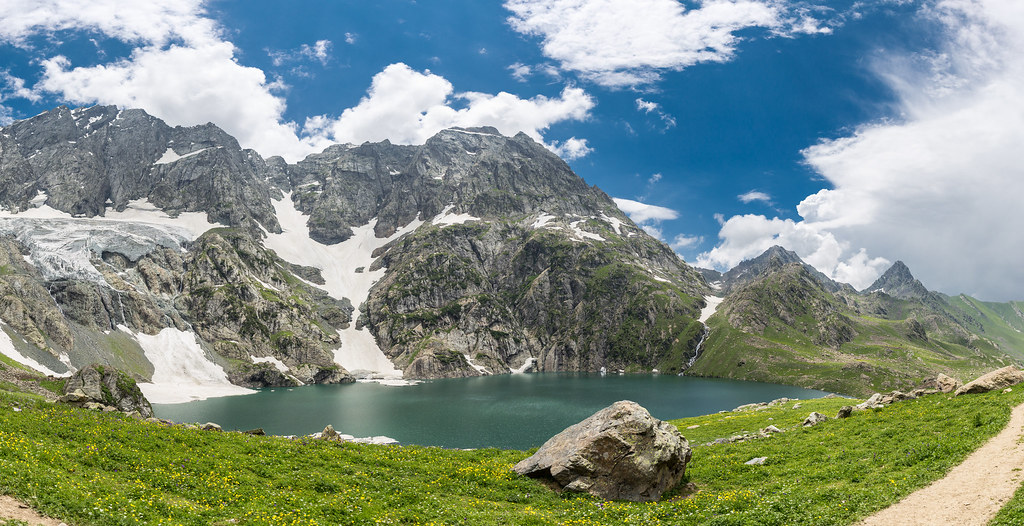
Gadsar Lake
Gadsar Lake is called the “Lake of Flowers.” It is one of the most beautiful lakes on the trek. This lake is at 13,750 feet, making it very high. In summer, wildflowers bloom all around the lake. It is colorful and looks like a painting. Many people believe the lake is sacred. The trek to Gadsar is hard, but the view is worth it. Once you reach, you will feel peaceful. The beauty of this lake is unforgettable.
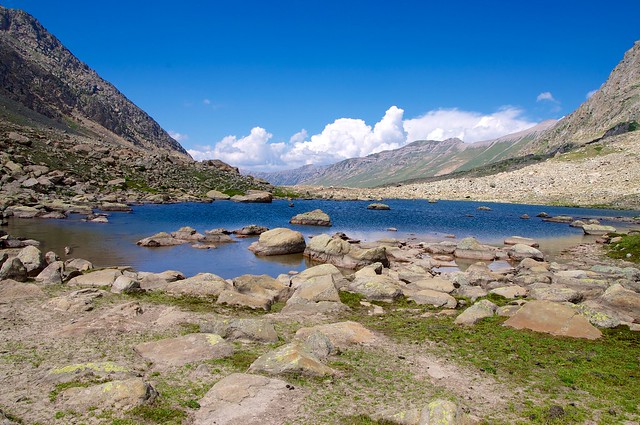
Satsar Lakes
Satsar Lakes are a group of seven small lakes. These lakes are at 12,000 feet. Each lake has its own charm. The lakes are fed by melting glaciers, so the water is very clear. The trek to Satsar is exciting. You pass through rocks, green fields, and lovely views. The area is perfect for camping or exploring. You can enjoy nature and have fun discovering the lakes. It is a special place for trekkers.
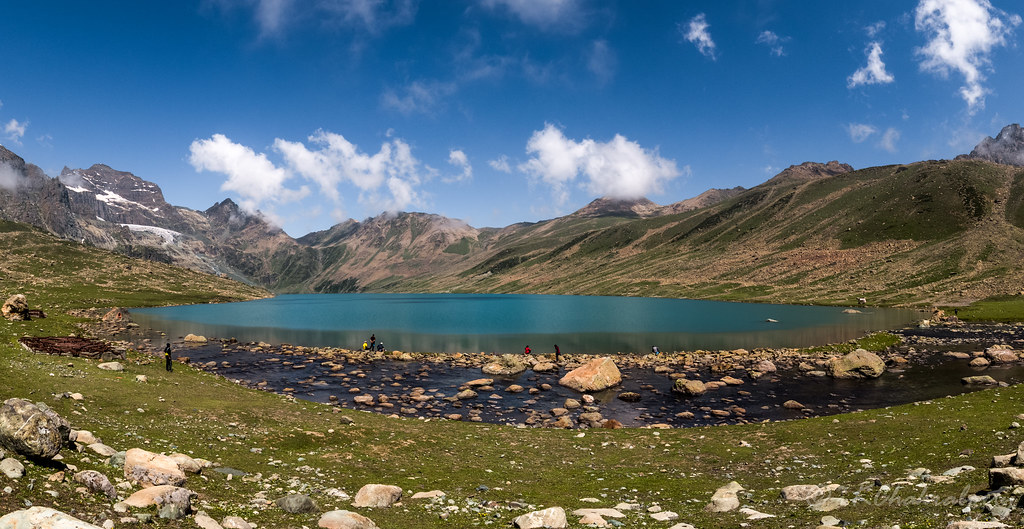
Gangabal Lake
Gangabal Lake is called the “Lake of Shiva.” It is the last major lake on the trek. At 11,500 feet, it is at the base of Mount Harmukh. The water is very clear and reflects the tall mountain. Many people come here because it is a sacred spot. Pilgrims and trekkers visit every year. The lake is also famous for trout fishing. The peaceful beauty of Gangabal Lake is perfect for ending your trek.
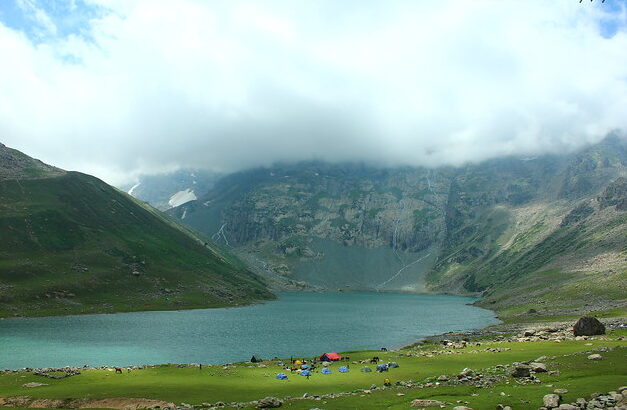
Nundkol Lake
Nundkol Lake is next to Gangabal Lake. It is smaller but just as beautiful. The lake is fed by snow from Mount Harmukh. It is a quiet spot, away from crowds. The clear water reflects the nearby peaks. Green fields around the lake make it perfect for camping. You can sit here and enjoy the calm. The lake feels peaceful and relaxing. Nundkol Lake is a hidden gem for those who love nature.
Top Photography Spots on Kashmir Great Lakes Trek
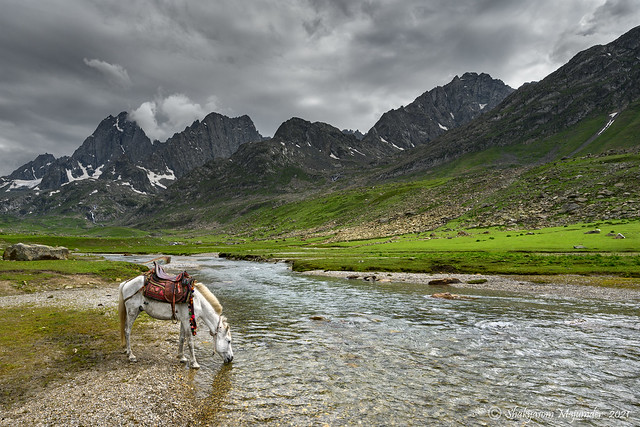
Sonamarg
Sonamarg is where the trek begins. It has green meadows, tall mountains, and a lovely river called the Sindh River. The view is perfect for wide, beautiful photos. Sheep and small villages add to the charm.
📸 Tip: Use a wide lens to show the big valley and include the river for depth.
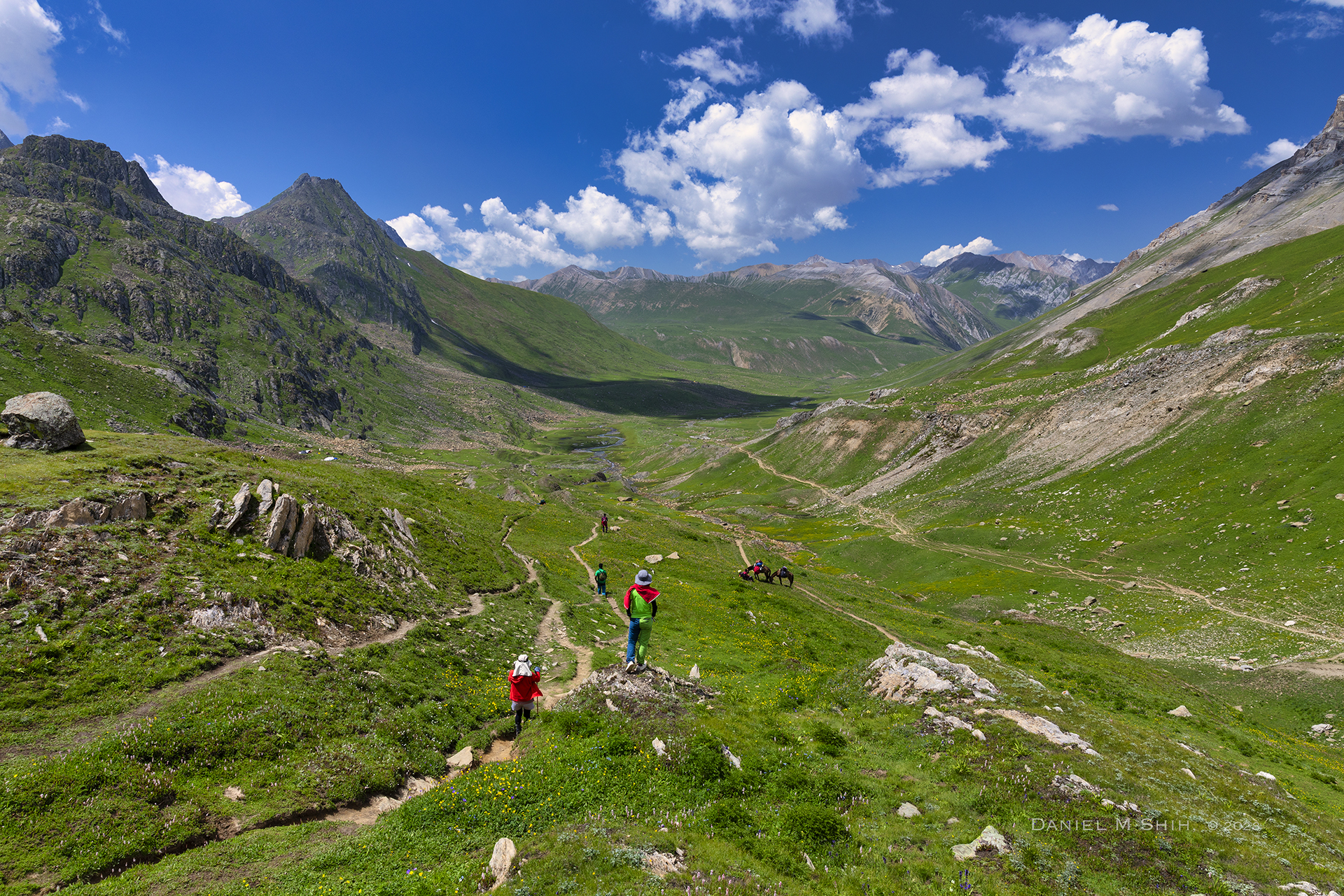
Nichnai Pass
On your way to Nichnai Pass, you’ll see fields of colorful flowers. At 13,000 feet, the pass offers amazing views of mountains and valleys.
📸 Tip: Take photos early in the morning when the valley has soft mist for a dreamy look.
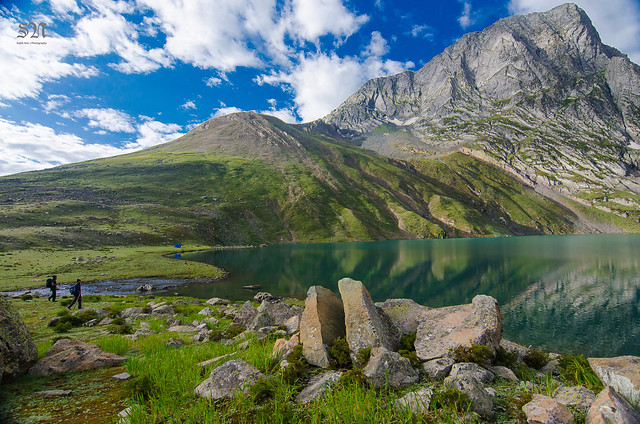
Vishansar Lake
Vishansar Lake is famous for its crystal-clear water. The lake reflects the sky and mountains like a perfect mirror. Its color changes from blue to turquoise during the day.
📸 Tip: Use a polarizing filter to make the colors brighter and cut down glare.
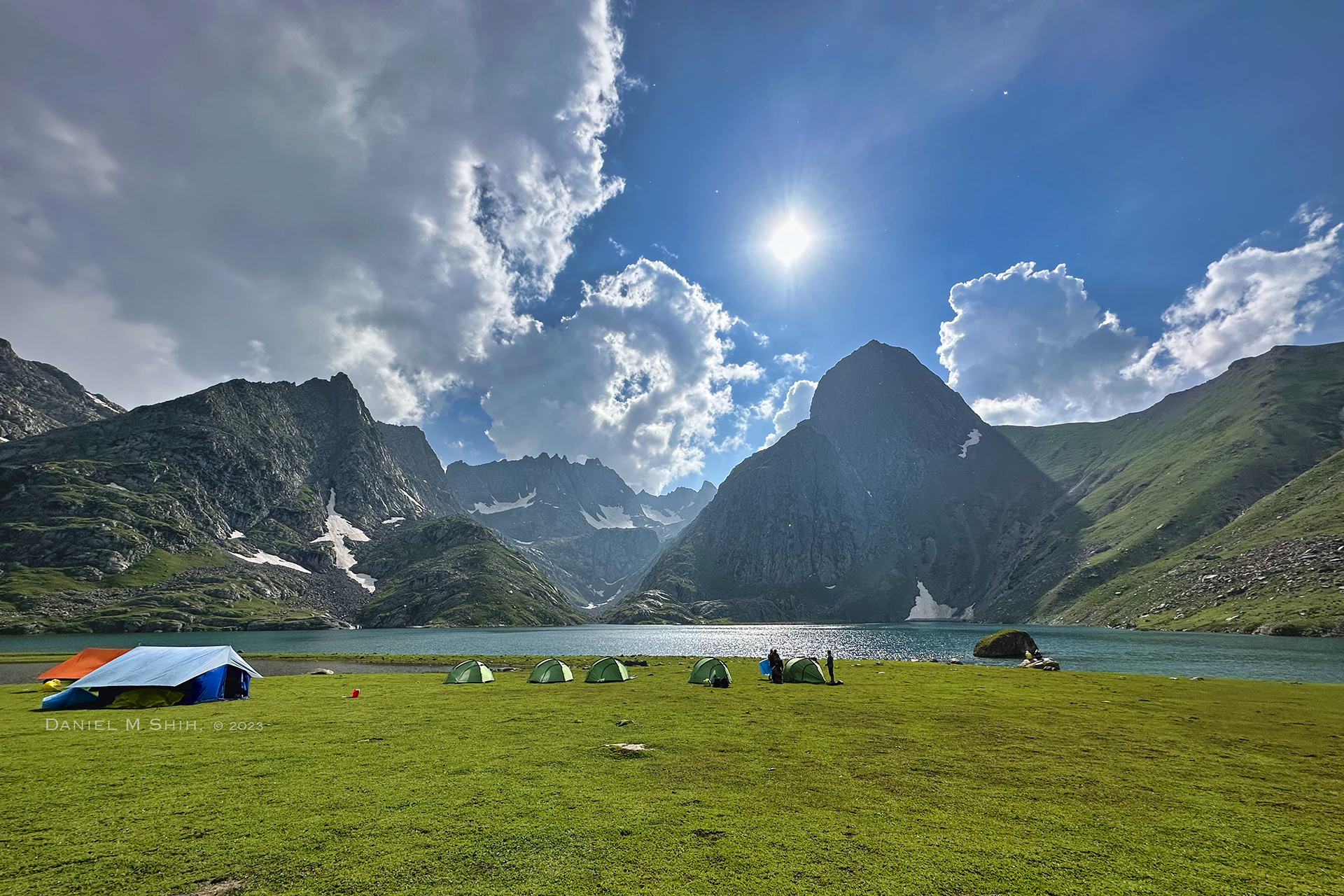
Krishansar Lake
Close to Vishansar, Krishansar Lake is quieter but just as beautiful. The green water and surrounding meadows make it a magical spot. You might also see birds here.
📸 Tip: Try long-exposure shots to show the calm ripples on the water.
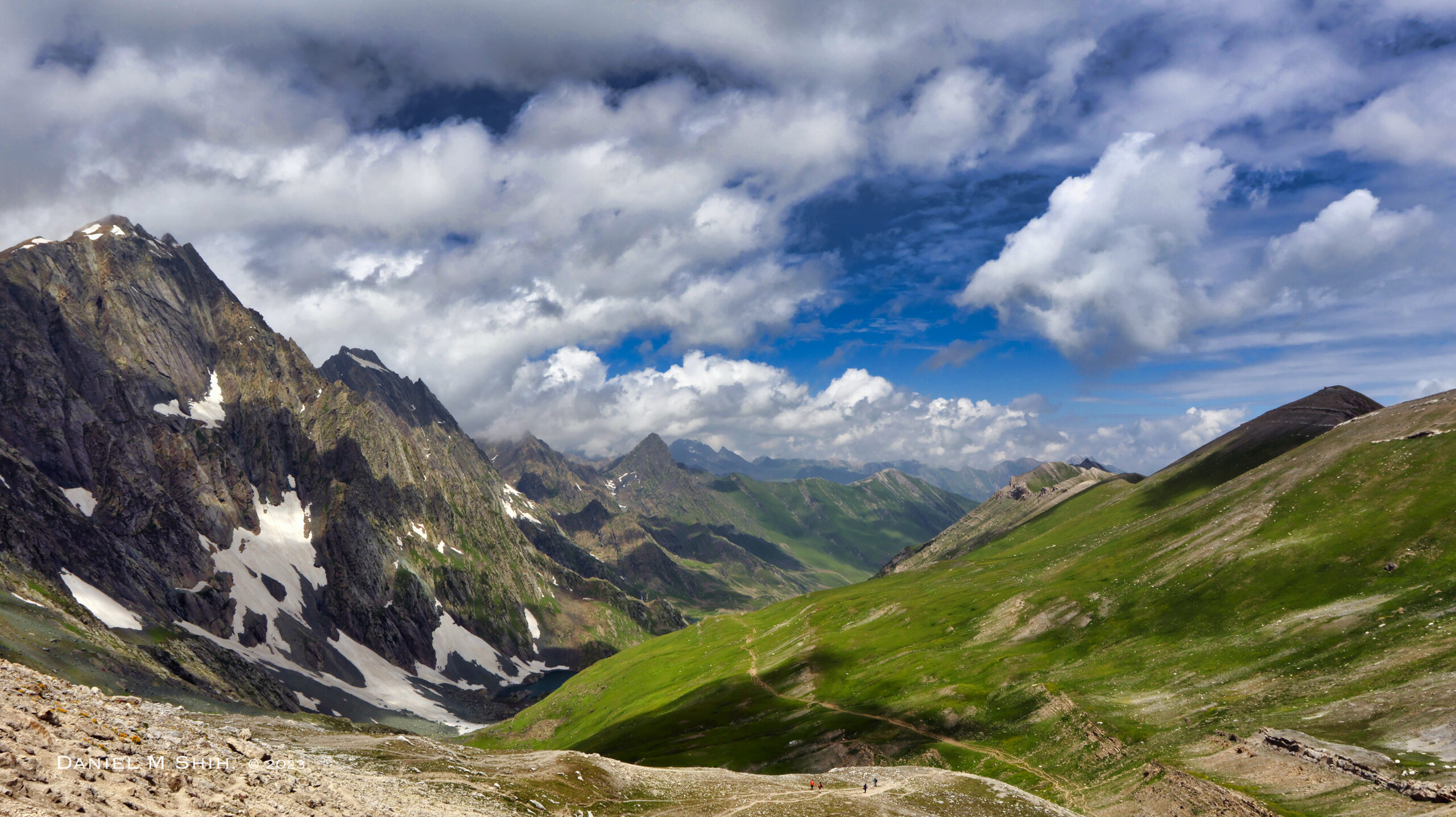
Gadsar Pass
At 13,700 feet, Gadsar Pass gives stunning views of two lakes on one side and the valley on the other. It’s a great place for wide, panoramic shots.
📸 Tip: Add people or trekkers in your photo to show how big the mountains are.
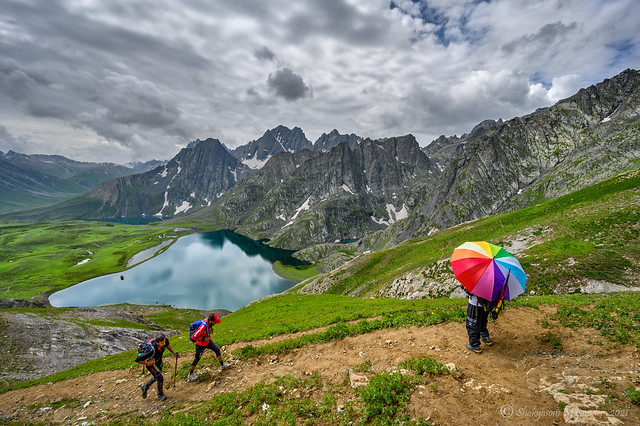
Gadsar Lake
Gadsar Lake is surrounded by colorful wildflowers. The clear water reflects the sky and mountains, creating perfect photos.
📸 Tip: Use flowers in the foreground for a beautiful frame.
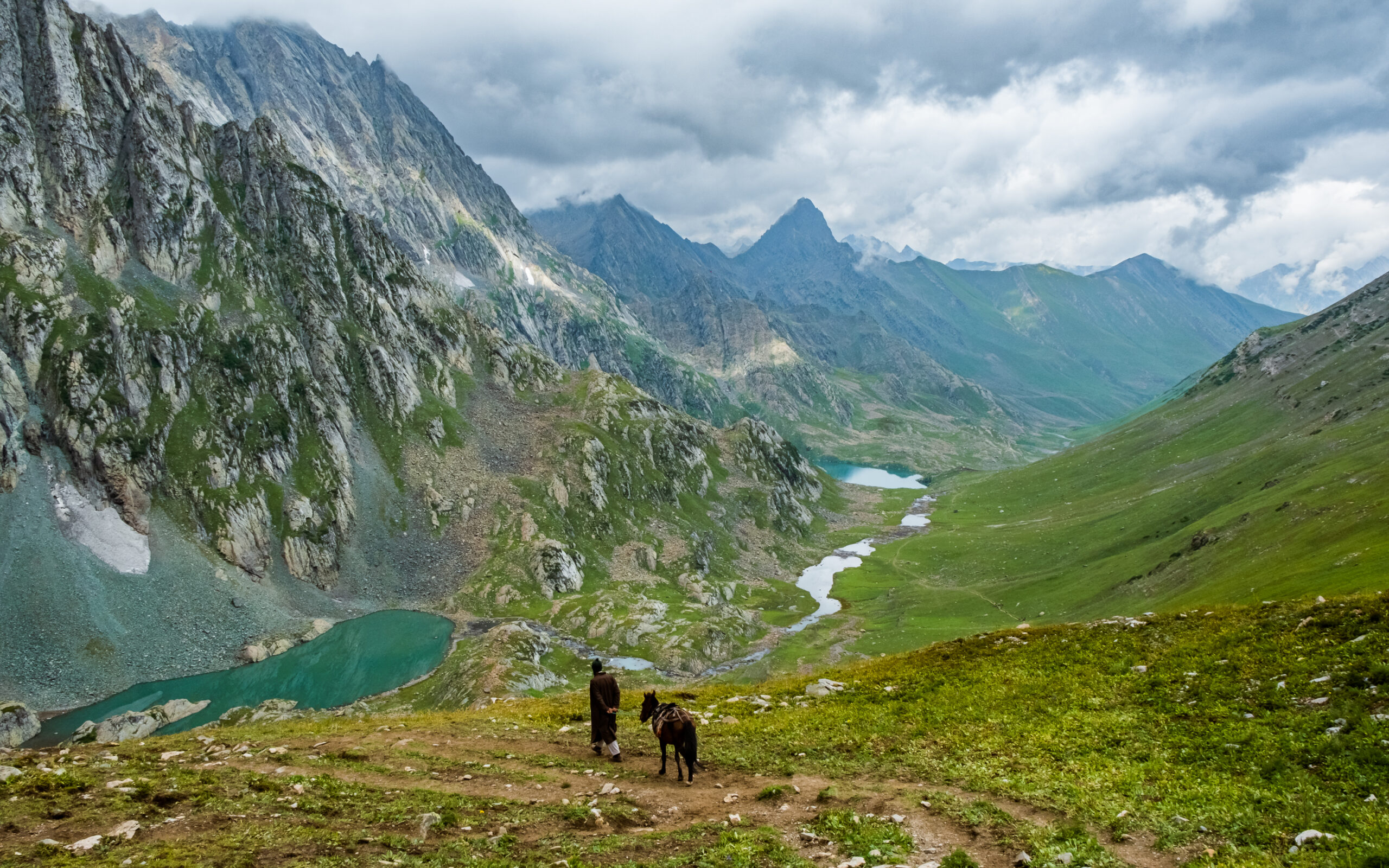
Satsar Lakes
The Satsar Lakes are seven small lakes connected by streams. They are surrounded by rocky meadows and are perfect for landscape and wildlife photos.
📸 Tip: Take photos during sunrise or sunset for golden light.
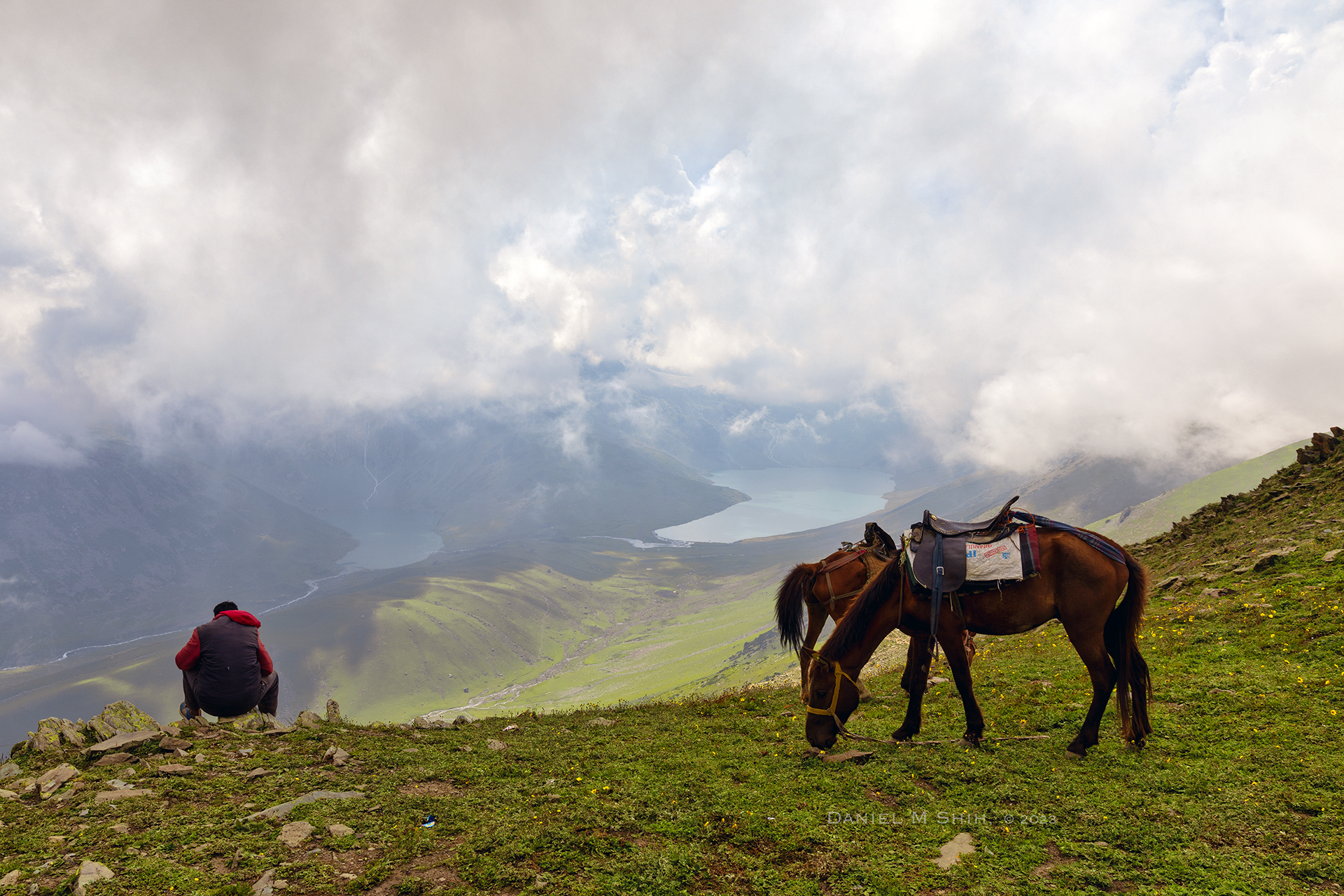
Zaj Pass
Zaj Pass offers some of the most dramatic views of the trek. You can see valleys, meadows, and glaciers from here.
📸 Tip: Use a zoom lens to capture details of the faraway peaks.
